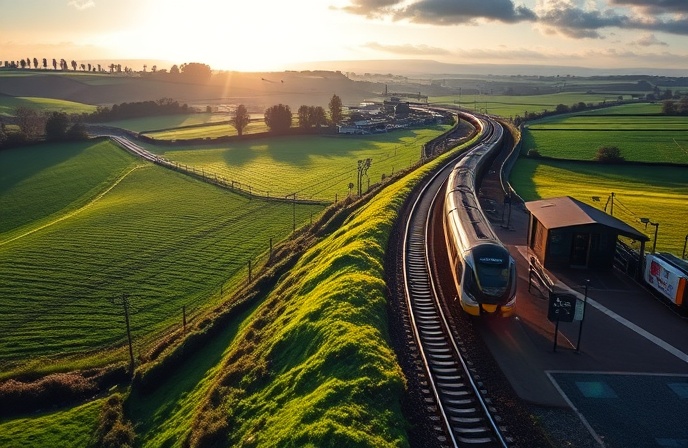KiwiRail’s High-Tech Track Upgrade: MERMEC’s ROGER System

This article delves into the recent acquisition by KiwiRail (New Zealand’s national rail operator) of a cutting-edge diagnostic vehicle from MERMEC, a leading provider of railway inspection systems. This purchase signifies a substantial investment in railway infrastructure maintenance and safety, highlighting the growing importance of preventative maintenance and technological advancements within the rail industry. The new vehicle will replace aging equipment, improving the efficiency and accuracy of track inspections across KiwiRail’s extensive network. We will examine the technological capabilities of the new diagnostic vehicle, its role in enhancing track safety and operational efficiency, and the broader implications of this acquisition for the future of railway maintenance in New Zealand and beyond. The analysis will explore the economic and operational benefits for KiwiRail, as well as the technological advancements showcased by MERMEC’s contribution to modern railway infrastructure management.
Modernizing Track Inspection with Advanced Technology
KiwiRail’s decision to replace its 41-year-old track safety unit underscores the critical need for modernizing railway inspection practices. The new MERMEC diagnostic vehicle incorporates advanced technologies such as laser scanning, various sensors, high-resolution cameras, and a sophisticated data management system. These features enable significantly more comprehensive and accurate track assessments compared to older methodologies. Laser technology, for instance, allows for precise measurement of track geometry, detecting even subtle deviations that could compromise safety or lead to future maintenance issues. The integrated sensor suite provides real-time data on a range of parameters, including track alignment, gauge, and surface condition. This data is then processed and analyzed by the onboard data management system, providing KiwiRail with a detailed and readily accessible overview of the track’s condition.
Enhanced Safety and Operational Efficiency
The implementation of this sophisticated diagnostic vehicle directly contributes to improved safety and operational efficiency within KiwiRail’s operations. Early detection of track defects, facilitated by the vehicle’s advanced technologies, allows for timely repairs, minimizing the risk of derailments and other safety-critical incidents. This proactive approach to maintenance reduces the likelihood of service disruptions, leading to improved reliability and customer satisfaction. Furthermore, the vehicle’s ability to comprehensively analyze 3,700 kilometers of track significantly increases the efficiency of inspection processes, reducing the time and resources required for traditional methods. The detailed data provided by the system also supports better planning and prioritization of maintenance activities, optimizing resource allocation and minimizing overall maintenance costs.
Strategic Implications for KiwiRail and MERMEC
For KiwiRail, the acquisition represents a significant investment in its long-term operational strategy. It signals a commitment to enhancing safety, reliability, and efficiency across its rail network. This upgrade reflects a proactive approach to asset management, moving away from reactive maintenance towards a more preventative model. For MERMEC, securing this contract represents a significant expansion of its international presence, highlighting the company’s technological leadership in the railway inspection sector. The success of this project in New Zealand could serve as a compelling case study, potentially attracting further business opportunities in other regions with similar needs for infrastructure modernization.
The ROGER System and its Capabilities
MERMEC’s ROGER (Rail Optical Geometry Evaluator and Recorder) line of diagnostic vehicles offers a range of self-propelled units with varying capabilities, operating at speeds ranging from 80 km/h to 200 km/h. This adaptability allows MERMEC to tailor its solutions to meet the specific needs of different rail networks. The specific model chosen by KiwiRail is not publicly specified, but it is clear that the selection reflects KiwiRail’s need for a high-performance system capable of handling the demands of its extensive network. The use of a self-propelled vehicle also simplifies the inspection process by eliminating the need for external haulage, saving time and resources.
Conclusion
The partnership between KiwiRail and MERMEC signifies a significant step towards the modernization of railway infrastructure maintenance and safety in New Zealand. The acquisition of MERMEC’s advanced diagnostic vehicle, likely a member of their ROGER series, represents a substantial investment in preventative maintenance strategies, enabling more efficient and accurate track inspections. This proactive approach minimizes the risk of derailments and other safety-critical incidents, leading to improved operational reliability and enhanced customer satisfaction. The sophisticated technology employed in the vehicle, including laser scanning, various sensors, and advanced data management capabilities, contributes to a comprehensive analysis of track conditions, allowing for early detection and timely repair of defects. This efficiency, in turn, leads to significant cost savings and optimal resource allocation. For KiwiRail, this investment underscores a commitment to long-term infrastructure development and improved operational efficiency. For MERMEC, it represents a strategic expansion into the Oceania region, reinforcing their global position as a leader in railway inspection technology. The success of this project will undoubtedly serve as a testament to the importance of technological innovation in maintaining safe, reliable, and efficient railway operations worldwide. The integration of advanced technology into railway maintenance is not merely a technological advancement; it’s a fundamental shift in operational philosophy, prioritizing proactive safety and streamlined efficiency over reactive problem-solving. This paradigm shift is expected to become increasingly prevalent across the global railway industry, as operators seek to optimize their operations and ensure the safety and reliability of their networks. The KiwiRail-MERMEC collaboration provides a compelling example of this transition, setting a benchmark for future infrastructure upgrades in the rail sector.




